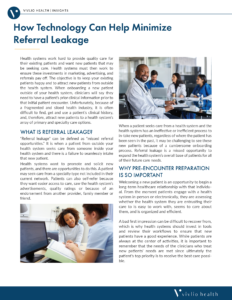When brand new patients seek care within your health system, it presents an opportunity and a challenge. An optimized intake process might just be the key to providing an excellent onboarding experience for that initial consult, and then retaining and offering additional specialty services for the life of the patient.
Health systems work hard to provide quality care for their existing patients and want new patients that may be seeking care. Health systems must then work to ensure these investments in marketing, advertising, and referrals pay off. The objective is to keep your existing patients happy and to attract new patients from outside the health system.
When onboarding a new patient outside of your health system, clinicians will say they need to have a patient’s prior clinical information prior to that initial patient encounter. Unfortunately, because of a fragmented and siloed health industry, it is often difficult to find, get and use a patient’s clinical history, and, therefore, attract new patients to a health system’s array of primary and specialty care options.
What Is Referral Leakage?
“Referral leakage” can be defined as “missed referral opportunities.” It is when a patient from outside your health system seeks care from someone inside your health system and there is a failure to seamlessly intake that new patient.
Health systems want to promote and solicit new patients, and there are opportunities to do this. A patient may seek care from a specialty type not included in their current network. Patients can also self-refer because they want easier access to care, saw the health system’s advertisements, quality ratings or because of an endorsement from another provider, family member or friend.
When a patient seeks care from a health system and the health system has an ineffective or inefficient process to in-take new patients, regardless of where the patient has been seen in the past, it may be challenging to see these new patients because of a cumbersome onboarding process. Referral leakage is a missed opportunity to expand the health system’s overall base of patients for all of their future care needs.
Why Pre-Encounter Preparation is So Important
Welcoming a new patient is an opportunity to begin a long-term healthcare relationship with that individual. From the moment patients engage with a health system in-person or electronically, they are assessing whether the health system they are entrusting their care to is easy to work with, seems to care about them, and is organized and efficient. A bad first impression can be difficult to recover from, which is why health systems should invest in tools and review their workflows to ensure that new patients have a good experience. While patients are always at the center of activities, it is important to remember that the needs of the clinicians who treat new patients’ needs are met since ultimately the patient’s top priority is to receive the best care possible.
Offer a smooth and consistent experience
Health systems want new patients and want to provide quality care. It is necessary to look at how the health system engages not only with a new patient but also with prior treating clinicians. For patients, it is vital to be able to make appointments that are convenient and in a time frame that enhances health and limits injury. For treating clinicians, it is vital to ensure they have the necessary prior patient clinical history and potentially prior lab results or images in advance of the encounter. Obtaining prior clinical information can be challenging for health systems when a patient comes from outside the health system, so health systems need to look at enhancing their ability to retrieve critical prior clinical information, regardless of where it may be – and asking new patients to do this can greatly enhance the future patient’s anxiety and inconvenience considerably.
Analyze your data and processes
The best decisions usually start with having as much information as possible. To increase capacity to see more patients, it is necessary to reduce inefficiencies, and be more effective at ensuring treating clinicians have what they need in a timely, consistent manner. Measurements and data about current processes, such as how long it takes and the steps that are taken to locate and retrieve clinical information from any source can assist in determining cost and whether patients have been turned away because of missing clinical information.
Give Staff the Tools They Need
Your health system wants to provide quality care to any patient needing treatment, so your staff needs tools to keep track of everything that ensures a smooth transition of care to your health system. Staff needs to have tools that track and monitor all the activities associated with accepting a new patient to your health system. Your clinical team wants to focus on understanding the patient’s clinical story using pertinent clinical information about the patient – and not tracking down where to find and retrieve this information.
Enhance care
Everyone involved in caring for patients want the best outcomes. A health system that has processes in place to assist staff and clinicians in providing care for their patients in a timely manner and with the necessary clinical information about the patient prior to the patient’s visit can lead to better patient outcomes. A health system that’s easy to work with – from both the patient and internal and external providers’ perspectives is a win for everyone involved.
At Vivlio Health, we provide a sophisticated, cloud-based application that helps doctors and health systems easily acquire prior medical record history for a patient. Find out how we can help your organization get a handle on referral leakage, increase new patient acquisition, build brand loyalty among your patients and be a good partner in providing quality coordinated care.





